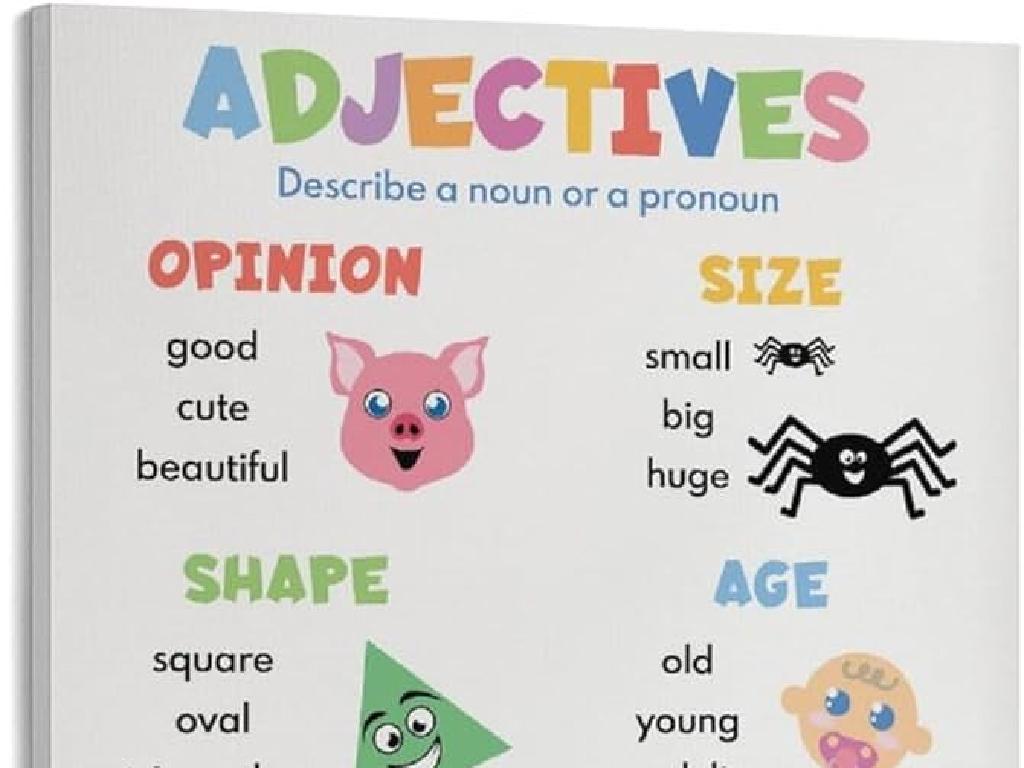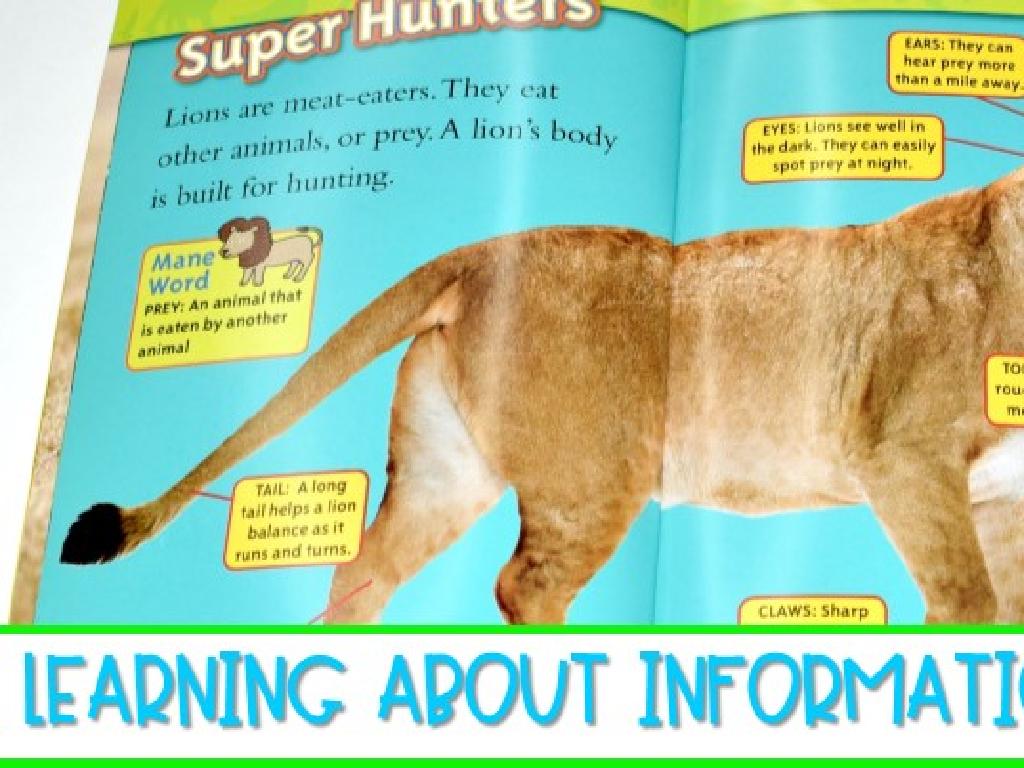Which Sentence Has The Same Meaning?
Subject: Language arts
Grade: Second grade
Topic: Categories
Please LOG IN to download the presentation. Access is available to registered users only.
View More Content
Today’s Adventure: Exploring Sentences!
– Sentences can have same meaning
– Words are different, meaning is same
– We’ll learn to spot similar sentences
– Look for the main idea in each sentence
– Practice with examples together
– ‘The cat ran swiftly’ has the same meaning as ‘The cat sprinted quickly’
|
This slide introduces the concept that different sentences can express the same idea using different words. It’s crucial for students to understand that while the structure and words may vary, the underlying meaning can remain consistent. Teach them to identify the main idea or action in a sentence and then find another sentence that conveys the same message. Use examples to illustrate this point and engage the class in a group activity where they match sentences with similar meanings. This will help develop their comprehension skills and ability to express ideas in multiple ways.
Understanding Sentences
– What is a sentence?
– A sentence shares a full thought.
– Sentences start with a capital
– Always begin with a capital letter.
– Sentences end with punctuation
– A period, question mark, or exclamation point finishes it.
– Sentences express complete ideas
– It should make sense on its own.
|
This slide introduces the basic concept of a sentence to second-grade students. Emphasize that a sentence is not just a random collection of words, but a complete thought that makes sense. Show them that every sentence begins with a capital letter, which signals the start of a new thought. Explain the different punctuation marks that can end a sentence: a period for statements, a question mark for questions, and an exclamation point for strong feelings or commands. Use examples to illustrate each point, and encourage students to come up with their own sentences. This foundational knowledge will help them in understanding how to identify sentences with the same meaning.
Matching Meanings: Same Idea, Different Words
– Sentences can have matching meanings
– Words in a sentence can be in different order
– The order of words can change but the meaning stays the same
– ‘The cat is on the mat.’
– Example of a sentence with a clear meaning
– ‘On the mat is the cat.’
– This sentence has the same meaning but the words are rearranged
|
This slide introduces the concept that sentences can be structured differently yet convey the same meaning. It’s important for second graders to understand that the order of words can change while the meaning remains the same. Use the example provided to show how the subject and the predicate can switch places without changing the sentence’s meaning. Encourage students to come up with their own examples of sentences that mean the same but are worded differently. This will help them develop a deeper understanding of sentence structure and meaning in language arts.
Let’s Practice Together: Matching Meanings
– Observe two different sentences
– Think about what each sentence means
– Consider the main idea of each sentence
– Decide if both sentences share the same meaning
– Look for similar words or phrases in both sentences
– Share your thoughts with the class
|
This slide is for a class activity aimed at helping second-grade students understand the concept of sentences having the same meaning. Display two sentences on the board and guide the students to think about the main idea conveyed by each sentence. Encourage them to look for keywords or phrases that are similar or convey the same idea. Ask the students to decide if the sentences mean the same thing and to explain their reasoning. For example, ‘The cat is chasing the mouse’ and ‘The mouse is being chased by the cat’ have the same meaning. This activity will help students with comprehension and recognizing synonyms and sentence structure. Prepare to facilitate discussion and provide feedback on their explanations.
Exploring Sentence Meanings
– ‘The dog chased the ball.’ vs. ‘The ball was chased by the dog.’
– Both sentences describe the same action with different word order.
– ‘She ate the cookie.’ vs. ‘The cookie was eaten by her.’
– These also describe the same action but with the focus on different subjects.
– Do these sentences mean the same?
– Understanding sentence structure
– Learn how changing the order of words can still tell the same story.
|
This slide is aimed at helping second-grade students understand that sentences can be structured differently and still convey the same meaning. The first pair of sentences demonstrates active voice versus passive voice, with the subject performing an action and then the action being performed on the subject. The second pair follows the same pattern. Ask the students if they think these sentences have the same meaning and why. This will help them grasp the concept of sentence structure and how it can change without altering the meaning. Encourage them to come up with their own examples and share them with the class.
Understanding Sentence Meanings
– Sentences can share meanings
– Different words, same story
– ‘The cat chased the mouse’ has the same meaning as ‘A mouse was chased by a cat’
– Subjects and verbs are key
– The ‘who’ is the cat (subject) and the ‘what’ is chased (verb)
– Recognizing similar sentences
– Find sentences that tell the same story even with different words
|
This slide aims to teach second graders that sentences can have the same meaning even if they are written differently. Emphasize that understanding the subject (who) and the verb (what) in a sentence helps us recognize when two sentences are telling the same story. Use examples to show how the same idea can be expressed with different words or sentence structures. Encourage students to think of their own examples and explain how they knew the sentences meant the same thing. This will help them understand the concept of synonyms and sentence rephrasing, which are important skills for reading comprehension.
Your Turn to Match: Sentence Meanings
– I’ll provide sentences to find pairs
– Focus on ‘who’ is doing something
– ‘Who’ refers to the subject of the sentence
– And ‘what’ are they doing
– ‘What’ refers to the action or the main event
– Match sentences with similar meanings
|
This slide is designed to engage second-grade students in an activity where they will practice matching sentences with the same meaning. The activity will help them understand the importance of identifying the subject (‘who’) and the action or event (‘what’) in a sentence to comprehend its meaning. For example, ‘The cat chased the mouse’ has the same meaning as ‘The mouse was chased by the cat.’ Both sentences have the same ‘who’ (the cat) and ‘what’ (chased the mouse). Encourage students to look for these key elements in the sentences they are matching. This exercise will enhance their reading comprehension skills and their ability to identify the main idea in a sentence.
Class Activity: Crafting Similar Sentences
– Create two sentences with the same meaning
– Pair up and share your sentences
– Discuss why the sentences are similar
– Think about the message in both sentences
– Listen to your partner’s sentences
– Are the words different but the idea the same?
|
This activity is designed to help students understand that different sentences can express the same idea. Students will create two distinct sentences that convey the same meaning. Afterward, they will pair up with a classmate to share and discuss their sentences. Encourage them to explain why they believe the sentences have the same meaning, focusing on the message rather than the exact words used. This will help them develop skills in paraphrasing and understanding synonyms. Possible activities for different pairs could include creating sentences based on a picture, a word, or a feeling. This exercise promotes critical thinking and enhances their ability to express ideas in various ways.
Great Job on Sentences!
– Celebrating our sentence exploration
– Sentences can have the same meaning
– Even if words are different, the main idea can be the same.
– ‘Same heart’ in different words
– Think of it like friends who dress differently but feel the same way.
– Keep practicing with new sentences
– Try to find sentences with the same meaning in your favorite books!
|
This slide wraps up the lesson on understanding that different sentences can express the same meaning. Reinforce the concept that the ‘heart’ or the main idea of a sentence can be the same even if the words used are different. Encourage students to think of sentences as people with different outfits but similar feelings. As a follow-up activity, students can be encouraged to continue practicing this skill by identifying sentences with the same meaning in books they enjoy or in conversations they hear. This will help solidify their understanding and application of the concept in real-life contexts.





